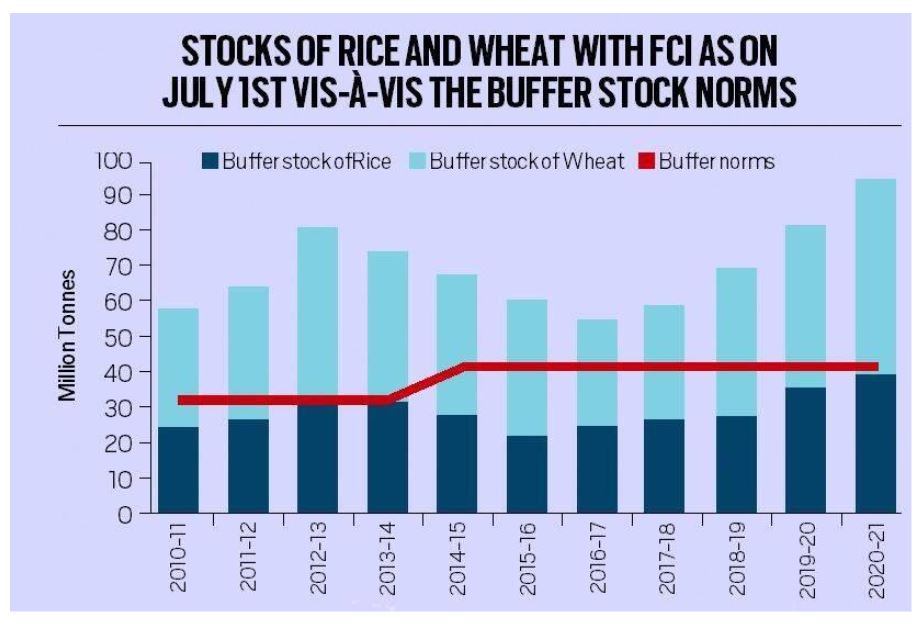UPSC Articles
AGRICULTURE/ GOVERNANCE
Topic: General Studies 2, 3:
- Public Distribution System- objectives, functioning, limitations, revamping; issues of buffer stocks and food security
- Government policies and interventions for development in various sectors and issues arising out of their design and implementation
MSP in the age of Surplus
Context: New Agricultural Laws being introduced by Union Government with an objective of making agriculture sector market oriented that would in turn help increase farmers’ income.
What is Minimum Support Price (MSP)?
- MSP is the price set by the government to purchase crops from the farmers, whatever may be the market price for the crops.
- MSP assures farmers agricultural income besides providing a clear price signal to the market
- The major objectives are to support the farmers from distress sales and to procure food grains for public distribution.
- The MSP is an assurance (not legal binding) by the government to the farmers that it will buy at this assured price if the market prices go below it.
MSP and the Changed Situation of Agriculture Sector
- The MSP regime was the creation of the era of scarcity in the mid-1960s
- Indian agriculture has, since then, turned the corner from scarcity to surplus.
- The policy instruments of dealing with shortages are different from those dealing with surpluses
- In a surplus economy, unless we allow a greater role for markets and make agriculture demand-driven, the MSP route can spell financial disaster.
- The new laws are trying to increase the relative role of markets without dismantling the MSP system.

Source: Indian Express
Criticism of MSP System
- Distorted Procurement: MSPs pertain primarily to paddy and wheat in selected states — in recent years, the government has also been buying some amounts of pulses, oilseeds and cotton occasionally.
- Buffer exceeding Limits: Due to MSP dominated system of rice and wheat, the stocks with the government are way above the buffer stock norms (see figure).
- High Cost of Procurement: The economic cost of procured rice comes to about Rs 37/kg and that of wheat is around Rs 27/kg.
- High Wages in FCI: The CTC (cost to company) of departmental labour of the Food Corporation of India is six to eight times higher than contract labour in the market.
- As a result, market prices of rice and wheat are much lower than the economic cost incurred by the FCI. In Bihar’s rural areas, for example, one can easily get rice in the retail market at Rs 23-25/kg.
- Export Inefficiency: The bottom line is that grain stocks with the FCI cannot be exported without a subsidy, which invites WTO’s objections.
- Food Subsidy Bill: The real bill of food subsidy is going through the roof but that is not reflected in the Central budget as the FCI is asked to borrow more and more. The FCI’s burden is touching Rs 3 lakh crore.
Is it right to compare sugarcane pricing and milk pricing by co-operatives in the same vein as the MSP?
- Sugarcane Pricing
- In the case of sugarcane, the government announces a “fair and remunerative price” (FRP) to be paid by sugar factories
- This has created mess in the Sugar Sector
- The sheer populism of SAP has resulted in cane arrears amounting to more than Rs 8,000 crore, with large surpluses of sugar that can’t be exported.
- This sector has, consequently, become globally non-competitive.
- Unless sugarcane pricing follows the C Rangarajan Committee’s recommendations — somewhat akin to milk pricing — the problems of the sugar sector will not go away.
- Milk Pricing
- The most important commodity of Indian agriculture, milk, whose value is more than that of rice, wheat, and sugarcane combined.
- In the case of milk co-operatives, pricing is done by the company in consultation with milk federations, not by the government. It is more in the nature of a contract price.
- Milk does not have a MSP and competes with private companies, be it Nestle, Hatsun or Schreiber Dynamix dairies
- Result: The milk sector has been growing at a rate two to three times higher than rice, wheat and sugarcane.
- Today, India is the largest producer of milk — 187 million tonnes annually — way ahead of the second-ranked US which produces around 100 million tonnes every year.
What are the good prospects with new agricultural laws?
- In the next three to five years, hundreds and thousands of companies will be encouraged to build efficient supply lines somewhat on the lines of milk, as a result of these changes in farm laws.
- These supply lines — be it with farmers producer organisations (FPOs) or through aggregators — will, of course, be created in states where these companies find the right investment climate.
- These companies will help raise productivity, similar to what has happened in the poultry sector.
- Milk and poultry don’t have MSP and farmers do not have to go through the mandi system paying high commissions, market fees and cess.
Conclusion
- The MSP system is much more costly and inefficient, while the market-led system will be more sustainable provided we can “get the markets right”.
- The pricing system has its limits in raising farmers’ incomes.
- More sustainable solutions lie in augmenting productivity, diversifying to high-value crops, and shifting people out of agriculture to high productivity jobs
Connecting the dots:
- History of Agriculture Produce Market Committees (APMCs)
- How has agri-marketing policy changed over years














